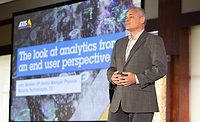
|
| Some school areas need additional protection because of their more expensive assets. Pictured is a computer lab at the Caddo Parish Public Schools in Shreveport, La. Photo courtesy of Stanley Security Solutions |
When it comes to integrating technologies, policies and procedures for K-12 and college organizations, the class acts are those that best know the classrooms, campus threats, security solutions, stakeholders, infrastructures, budgets and culture all wrapped inside these “micro-communities.”
Just listen to Bob Stockwell, global technology leader, who often covers K-12, and Eric Rittenhouse, commercial leader - higher education, both with Stanley Security Solutions.
When it comes to K-12 facilities, “solid access controls are important. It is best to limit access from the outside to two or three points,” advises Stockwell. And, when it comes to security video, among important placements “are exits and entrances, the parking areas at bus loading areas and even on the buses themselves,” he adds. “Look for those choke points when considering traffic patterns and address the security needs there for a safer environment.”
When it comes to higher education campuses that often have more buildings open for more hours of the day, Rittenhouse suggests prioritizing according to sensitivities and assets beyond basic security. “Where there is high value or expensive assets, campus security executives may need additional tech-based solutions” in addition to policies and procedures, he says. “For example, in some cases, consider radio frequency identification or RFID-based tracking of certain assets, which may be worth the cost.”

|
| A unified approach to security and life safety makes the most sense for college and university settings, says Eric Rittenhouse, commercial leader - higher education, Stanley Security Solutions. Photo courtesy of Stanley Security Solutions |
On the K-12 side, in past studies of responding to intrusion alarms, schools were high up in terms of false alarms. To get more reliable response, the Stanley integrators urge facilities to move to “verified response, especially through audio verification.”
On college and university campuses, “an integrated approach to security and life safety” makes the most sense, says Rittenhouse. “A unified answer” holds the most promise as security works more closely with student life and IT executives as well as their integrator. “The aim is situational awareness,” he says. And, these days, such awareness needs to be shared with first responders, too. Rittenhouse also says that things are maturing with security on college campuses and that the integrated platform is so essential. He suggests looking at the various perimeters as well as labs, dorms and smart classrooms with expensive equipment. “We are seeing a shift to more secure access cards such as PIV-like smart cards and biometrics such as iris scanning,” he explains.
In addition, there continues to be a choice between wired and wireless solutions.
The Stanley integrators have some general advice: Wireless is reliable and fits into challenging locations. But, “when it comes to situations where there is need for immediate lockdown, that calls for a wired solution,” Rittenhouse comments. He also sees a move to integration of computer and physical access controls for a number of colleges and universities.

|
| It is best to limit access to K-12 facilities, advises Bob Stockwell, global technology leader, Stanley Security Solutions. Photo courtesy of Stanley Security Solutions |
For security video, whether K-12 or higher education, the solid trend is toward better image clarity and solutions such as license plate recognition, especially for institutions with challenging parking needs. Also, shared across all types of educational facilities is the need for mass notification. “The more ways you get the word out, the better,” adds Stockwell. And, for new construction, the quicker and more involved a security integrator is in the design phase, the better, according to Rittenhouse.






